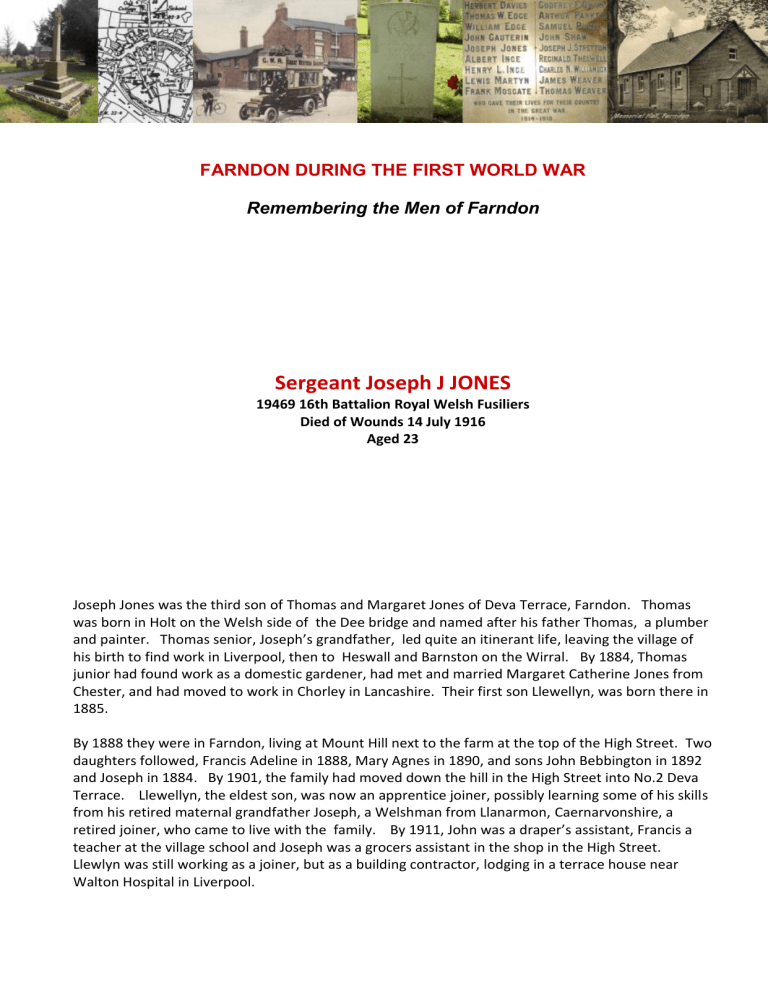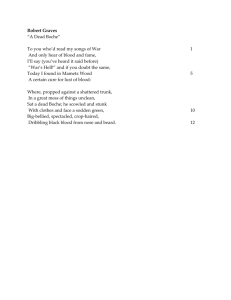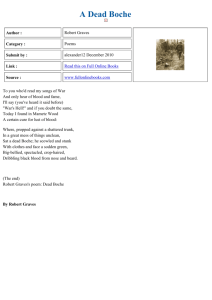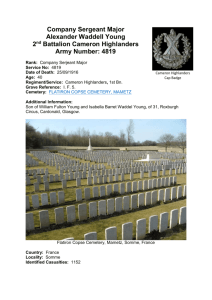thomas william edge

FARNDON DURING THE FIRST WORLD WAR
Remembering the Men of Farndon
Sergeant Joseph J JONES
19469 16th Battalion Royal Welsh Fusiliers
Died of Wounds 14 July 1916
Aged 23
Joseph Jones was the third son of Thomas and Margaret Jones of Deva Terrace, Farndon. Thomas was born in Holt on the Welsh side of the Dee bridge and named after his father Thomas, a plumber and painter. Thomas senior, Joseph’s grandfather, led quite an itinerant life, leaving the village of his birth to find work in Liverpool, then to Heswall and Barnston on the Wirral. By 1884, Thomas junior had found work as a domestic gardener, had met and married Margaret Catherine Jones from
Chester, and had moved to work in Chorley in Lancashire. Their first son Llewellyn, was born there in
1885.
By 1888 they were in Farndon, living at Mount Hill next to the farm at the top of the High Street. Two daughters followed, Francis Adeline in 1888, Mary Agnes in 1890, and sons John Bebbington in 1892 and Joseph in 1884. By 1901, the family had moved down the hill in the High Street into No.2 Deva
Terrace. Llewellyn, the eldest son, was now an apprentice joiner, possibly learning some of his skills from his retired maternal grandfather Joseph, a Welshman from Llanarmon, Caernarvonshire, a retired joiner, who came to live with the family. By 1911, John was a draper’s assistant, Francis a teacher at the village school and Joseph was a grocers assistant in the shop in the High Street.
Llewlyn was still working as a joiner, but as a building contractor, lodging in a terrace house near
Walton Hospital in Liverpool.
Deva Terrace
Top: The Jones family lived in the middle cottage at No.2. The terrace can also be seen in the bottom view of 1905, on the right beyond the white fronted Greyhound Inn (the original Inn).
High Street Farndon c.1905
Looking back up the hill from Deva Terrace
(arrowed)
Brief ancestry tree of Joseph Jones.
Compiled by ‘dmands82’
Modern map of Farndon
Parish. Holt is on the
Welsh side of the Dee, the birthplace of Joseph’s father Thomas.
Census 1871
The family of Thomas Jones – Joseph’s father, Thomas junior, is shown aged ten.
Census 1891
The family of Thomas Jones junior – Mount Hill, Farndon
Census 1901
The family have now moved to Deva Terrace – Joseph Jones aged seven
Census 1911
Joseph Jones is now a Grocer’s Assistant aged seventeen.
Also recorded is schoolmaster Joseph Thomason, a ‘visitor’ – the future husband of Joseph’s sister Frances, also a teacher .
When the war came, it is likely that Joseph was an early volunteer [his war record has not survived, but his medal card indicates he was in France by 2 December 1915] and as the son of Welsh parents he went off to Wrexham to enlist for the Royal Welch Fusiliers, where he was posted to the 16th (Service)
Battalion. The 16th Battalion was raised at Llandudno in November 1914 by the Welsh National Executive Committee from recruits surplus to 13th
Battalion (1st North Wales) which had been formed in Rhyl on 3 September
1914. Later in the month they joined 128th Brigade, 43rd Division at
Llandudno, which was renamed 113th Brigade, 38th (Welsh) Division on the 28
April 1915. They were then moved to Winchester in August 1915 for final training, before embarking for the Front, landing in France in December 1915, taking up the line near Fleurbaix. Joseph must have been with them from an early stage and followed this itinerary.
Their first winter was spent in the trenches near Armentieres, after which they were moved behind the lines, where the 38th Division began the long march south to the Somme arriving in June 1916. Ten battalions of the Royal Welch
Fusiliers (RWF) became part of the British Army's huge concentration of men and firepower, which was to begin a major assault on the German front line, soon to be known officially as the First Battle of the Somme. Two were Regular battalions, and another was a pre-war Territorial battalion. The other seven battalions consisted of men who had answered Lord Kitchener's call for volunteers early in the war, and five of these 'New Army' battalions (13th-17th RWF) were in brigades 113 th
and
115 th
– part of the aforementioned 38th (Welsh) Division – Lloyd George's 'Welsh Army'. Sergeant
Joseph Jones’ 16th Battalion were part of this force.
The Battle began on 1 July, but the Division were tasked with the capture of Mametz Wood, which began a few days later on 7 July. They were met with fierce resistance, and it took until the 14 July to clear the wood. This was the first major action fought by the Division and its Welsh battalions. The first assault on the 7 July failed, but a renewed attack was made early on 10 July by the 113th and
114th Brigades, and gained a foothold in the Wood. Well until late the following day, Welsh battalions fought their way through the chaotic, shattered and bewildering mass of broken timber and dense undergrowth against an unseen enemy, preceded by a creeping artillery barrage which added to the deafening noise and further uprooted or brought down trees. To add to the horror and confusion, this even fell at times on their own men. Finally, on the night of 11/12 July the Germans withdrew from the Wood, leaving behind hundreds of dead.
This capture of the wood is now regarded as being attributed wholly to the 38th (Welsh) Division, but it came at great cost to the Division; nearly 4,000 men were lost, including 600 killed and as many missing. The five RWF battalions lost well over 1,000 men, including four out of five commanding officers. It is worth bearing in mind that not one man in the Division had been trained to fight in thick woodland, and for the majority this was their first experience of battle.
Nevertheless, the Commander in Chief, Field Marshal Sir Douglas Haig was moved to write in his diary that '...The 38th Welsh Division had not advanced with determination to the attack' – a view that was slammed by later commentators as a totally unjustifiable accusation, based on incomplete information. In fact, the 115th Brigade lost more than 600 men in this stage of the battle.
Sergeant Joseph Jones was one of those who was cut down in the battle to clear Mametz Wood. He was seriously wounded, but was recovered from the battlefield and taken behind the lines to a casualty clearing station, from where he was despatched to the Base Hospital at Rouen. Nothing could be done, and Sergeant Joseph Jones died of his wounds a few days later on 14 July 1916 at the age of twenty-three. He was buried in the nearby St. Sever Cemetery.
Commissioned into the Royal Welsh Fusiliers in August 1914, the distinguished author Robert Graves was with the 2nd Battalion on 16 July, bivouacked outside Mametz Wood among the dead of the Regiment's New Army battalions. In the original edition of Goodbye to All
That (1929), he described how he went out into the wood to scrounge blankets for his men:
“I had to pass the corpse of a German… propped against a tree. He had a green face, spectacles, close-shaven hair; black blood was dripping from the nose and beard. He had been there for some days and was bloated and stinking.”
He later recaptured the experience of death and destruction in one of his most famous poems, in similar sentiment to Owen’s Dulce et Decorum Est :
' A Dead Boche '
To you who’d read my songs of War
And only hear of blood and fame,
I’ll say (you’ve heard it said before)
“War’s Hell!” and if you doubt the same,
Today I found in Mametz Wood
A certain cure for lust of blood:
Where, propped against a shattered trunk,
In a great mess of things unclean,
Sat a dead Boche; he scowled and stunk
With clothes and face a sodden green,
Big-bellied, spectacled, crop-haired,
Dribbling black blood from nose and beard.
Robert Graves (1895–1985) Fairies and Fusiliers 1918
An insightful account of the battle came from the pen of Thomas Phillips. Although originally from
Llanelli, he spent some time in Wrexham, where his son William was born. He was an acting Sergeant in the 16th Battalion during the Mametz action, and probably knew Sergeant Joseph Jones. He described what happened in vivid detail,
WITH THE 38th DIVISION IN FRANCE
At this place we saw our first batch of Boche prisoners placed in the cage. We only stayed at
RIBEMONT one night. At noon the following day we were hurriedly dispatched to reinforce, leaving all surplus kit behind. After a few hours’ march we were met by guides from a (the?)
Staffordshire Regiment, and ultimately found ourselves consolidating the newly occupied line of German trenches in front of FRICOURT, a village which, on the previous day, had been completely demolished by our Gunners. For the following five days we occupied these trenches, and by this time the Division had completely relieved the troops who had taken this ground.
The Battalion suffered slight casualties in this area and, at the end of the tour, marched back some distance where we bivouacked. Improvised shelters out of ground sheets were made, and it rained very heavily. The following day we had orders to move forward again, and (we) relieved the 15th RWF in the front line, which system of trenches was half a mile in advance of
FRICOURT. We remained in these trenches for four or five days and, although our relief had
Trench Map showing Mametz Wood
The site of the ‘Red Dragon Memorial’ is arrowed
been expected, in fact arranged but afterwards cancelled, we had orders on the night of the
9th/10th July to take Mametz Wood. Towards the evening of Sunday 10th July a message was received from the GOC Commanding, on the vast importance of taking this wood, and that it was up to the Welsh Division to maintain the traditions of the British Army and win for itself immortal glory, which it did. It was 10.00 PM when all officers were hurriedly summoned to a conference where the method of attack was fully discussed. The disposition of the Companies was as follows:
“B” and “D” Coys supported by “C” and “A”, the extension covering a front of 200 yards and going forward in successive waves. Colonel Carden, to whom this great task was entrusted, addressed the men before going into action saying, “Boys, make your peace with God; we are going to take that position and some of us will not come back.”
For the next few hours there was little time for rest of any sort, and finally arrangements had to be accelerated. At 2.30 AM on the 10th July the Battalion was assembled in extended order out of the trenches, and lay in prone position until 5.00 AM. During these 2½ hours the roar of our guns was deafening and the concerted action of the machine gunners added to the din.
The suspense was very keen till we had the order to move forward at 5.00 AM.
The dawn had broken and daylight was fast approaching, enabling us to see the ground we had to cover. We slowly ascended the ridge in front of White Trench (properly called such, as it had been dug out of chalk), and within 10 minutes or so a verbal order was passed down from our right to retire. No-one seemed to know from where this order emanated, but obviously it came from the 14th RWF as they were on our right. “B” and “D” Companies had gone too far forward for this order to be communicated to them. Presumably, if it had, the dauntless and courageous Colonel Carden would not have acted on it as he had set his teeth on getting to the wood. “A” and “C” Company officers were compelled to re-enter the assembly trench in compliance with this order. Orders were rapidly passed down to open fire (as) soon as the
Boche appeared in view. Seconds seemed like minutes, and minutes like hours. In due time we saw the Boche but alas, unarmed with hands up, and escorted by one or two Tommies. These prisoners had been taken by “B” and “D” Companies. One of the escort waved his arm as a signal to go forward again and out of the trench everyone leapt without waiting for definite orders from superior officers. It displayed the instinctive valour of a British Tommy and individual determination to gain the objective. On we went in single file through a heavy Boche barrage and, on the other side of the crest was a steep embankment which offered the enemy machine gunners a good field of fire. I do not remember going down this embankment at all as
I was so wrapped up in the task allotted to me. I was entrusted with the communications of the 113th Brigade.
Our first objective was to get to the wood and, for the purpose of re-organisation, seek natural cover in the folds of the ground. At this juncture the enemy put up a heavy barrage of incendiary shells that burst 100 yards or so short. The sudden burst of flame which extended from the point of bursting, 200 feet high, to the ground had a demoralizing effect, as no-one in the Battalion had previously heard of them. Colonel Carden was mortally wounded within 20 yards of the wood. After a brief stay the troops went forward into the wood, entering it at the nearest point which, for the purpose of clarity, can be described as the apex of a triangle. At this point the Boche had three machine gun posts which momentarily checked our entrance.
These machine gunners were dealt with.
We pressed on until the second objective was reached. I skirted the edge of the wood and ascended the slope till I could be seen by the Brigade forward telephone station, and in doing so had to dodge the bullets which were fired by snipers up in the trees. I succeeded, with the help of my signallers, to maintain communication during the whole time of this inferno, and the chief messages required to be sent were for more and more stretcher bearers. The
Battalion suffered a loss of about 400 casualties in this struggle, out of 600 who went into action.
During the same evening we were relieved by an incoming battalion, and we retired to a sunken road called Queens Nullah, immediately behind the Chalk Trench. We had to be on the
“qui Vive” all night as all sorts of reports were flying about. Early next morning I witnessed one of the best artillery movements I have ever seen; that of a Battery riding into action under heavy fire. We rested during the day on their left, and our time was chiefly taken up by devouring the Brigade rations which had been dumped nearby. Ample justice was made to the selection of ham, cheese, bread, rum etc which we had, as we had been on biscuits and water only during the 4/5 days we had occupied the trenches in front of FRICOURT. Our transport could not get anywhere near us. We were in very poor physical condition on the day of the
12th and, as we had been under such heavy fire for several days and nights, (we) did not regard the shelling we were subjected to on this day as of much consequence. Late in the afternoon the Boche guns got our range and pummelled Queens Nullah, causing several casualties to the few of us that remained. It was here that I narrowly escaped death myself and instead, received a wound in the chest and leg, as well as being crushed by a fall.”
18531 Tom Phillips, Signalling Sergeant “C” Company, 16th Royal Welch Fusiliers
(from a document donated to the Royal Welch Fusiliers Museum by his grandsons).
In the days that followed, the fighting moved to the north and east of Mametz Wood into the
German second line defences. On 14 July, the 1st Battalion took part in the 22nd Brigade's successful assault on Bazentin-le-Petit village, and played a notable part in repulsing subsequent German counter-attacks. Then on 18 July, the 10th Battalion distinguished itself in the attack on Delville
Wood where two of its number, Corporal J.J.Davies and Private A.Hill, were awarded the Victoria
Cross on that day; although the Battalion lost 228 men, including 15 officers.
On 20 July, the 2nd Battalion drove the enemy out of High Wood but was subsequently ordered to withdraw – their Commanding Officer wrote of his men,
‘ I have never seen such a magnificent and wonderful disregard for death as I saw that day. It was almost uncanny it was so great – but of the 706 men who went into the wood, fewer than
100 emerged unwounded’.
But before this, shortly after the battle for Mametz Wood ended, the 38th (Welsh) Division, including its Royal Welch Fusiliers had been pulled out and did not return to major action for more than a 12 months. Colin Hughes, in his work, ‘Mametz - Lloyd George’s Welsh Army at the Battle of the
Somme’ wrote that they had
...neither glory nor distinction...noticeably bestowed upon them, [but] instead were bundled unceremoniously away to a quiet sector of the Front, and took no further part in the fighting on the Somme.
The sacrifice of these brave men has not been forgotten, and it was fittingly remembered with the installation of the splendid red dragon of Wales, once the proud emblem of the 38th (Welsh)
Division, looking out at the jumping off point towards Mametz Wood, where so many fell including
Sergeant Joseph Jones of Farndon a century ago.
Above: Soldiers of the 16 th
Battalion, Royal Welch Fusiliers
Bottom: The remnants of
Mametz Wood
The poet Robert Graves fought in the battle and described the wood immediately after the battle;
It was full of dead Prussian
Guards, big men, and dead
Royal Welch Fusiliers and South
Wales Borderers, little men. Not a single tree in the wood remained unbroken.
German ammunition wagons destroyed by British shellfire, Mametz Wood, July 1916
Another way to render German artillery ineffective was to wreck the supply system. Here, a small shell dump has been bombarded and several ammunition wagons severely damaged, although few shells seem to have exploded. The lack of permanent damage shows why the BEF focused, where possible, on destructive counter-battery fire. While this was doubtless a successful small bombardment, its effects would have been purely transitory, unless the British infantry happened to capture a particular position because some German batteries were short on shells at the key moment.
ST. SEVER CEMETERY and EXTENSION, ROUEN
During the First World War, Commonwealth camps and hospitals were stationed on the southern outskirts of Rouen. A base supply depot and the 3rd Echelon of General Headquarters were also established in the city. Almost all of the hospitals at Rouen remained there for practically the whole of the war. They included eight general, five stationary, one British Red Cross and one labour hospital, and No. 2 Convalescent Depot. A number of the dead from these hospitals were buried in other cemeteries, but the great majority were taken to the city cemetery of St. Sever. In September
1916, it was found necessary to begin an extension, where the last burial took place in April 1920.
During the Second World War, Rouen was again a hospital centre and the extension was used once more for the burial of Commonwealth servicemen, many of whom died as prisoners of war during the German occupation. The cemetery extension contains 8,346 Commonwealth burials of the First
World War (ten of them unidentified) and 328 from the Second World War (18 of them unidentified).
There are also 8 Foreign National burials here. The extension was designed by Sir Reginald Blomfield.
Sergeant Joseph Jones was buried in plot reference A. 29. 10.
Right: Plan of St Sever Cemetery and St. Sever Cemetery Extension
Modern map of the area south of the Somme (top right – Beaumont Hamel-Peronne), showing location of Rouen (Base Hospital No.2 and St Sever Cemetery) bottom left.
Below:
St Sever Cemetery and St. Sever Cemetery Extension
St Sever Cemetery and St. Sever Cemetery Extension
The Mametz Wood Memorial
The memorial commemorates the engagement of the 38th (Welsh) Division during the First Battle of the Somme.
It was erected in 1987 by Welsh sculptor
David Petersen, and is a large Welsh red dragon on top of a three-metre stone plinth, facing the wood and tearing at barbed wire. It was commissioned by the
South Wales Branch of the Western Front
Association following a public fund-raising appeal (refurbished for the centenary).
The memorial is located near the ‘jumping of point’ for the engagement and looks out over Mametz Wood.
The Mametz Wood Information Board is also pictured.
Photos by the author on a visit in 2005.
The Division suffered terrible casualties at
Mametz, and were taken out of the line, and moved to Ypres to rebuild.
Here they fought at Pilckem and Langemarck, then moved to Armentieres, where they remained from September 1917 until March,
1918 when the German Spring Offensive was launched.
The British had been over-run on the Somme, and so in April the Division was moved south, taking up positions North of Albert, from where they weathered the storm of the coming months, until the war turned during the Battle of Amiens, on the 8th August, 1918.
The Germans had now lost the upper hand, and the British regained the lost ground on the
Somme after an attack which began on the 21st
August, with the 38th Welsh in the midst of the attack during the Battle of Albert.
Farndon War Memorial
Left: the memorial plaque located in the entrance hall in the adjacent Memorial Hall (top left).
Above: Medal Card
Below: Service Medals (1915 Star, Victory Medal, and British Medal)
Memorial Plaque and Scrolls
Researched and written
by







